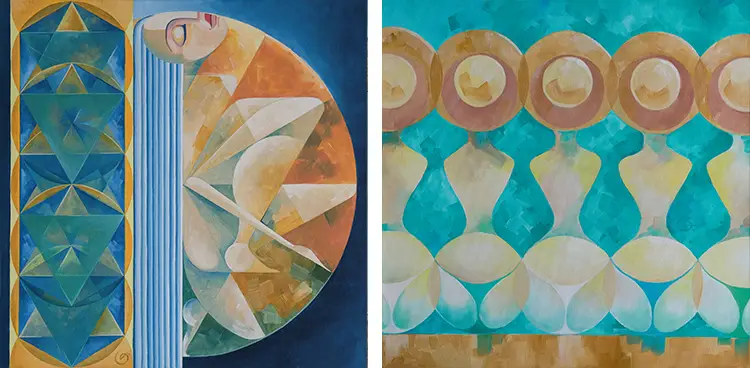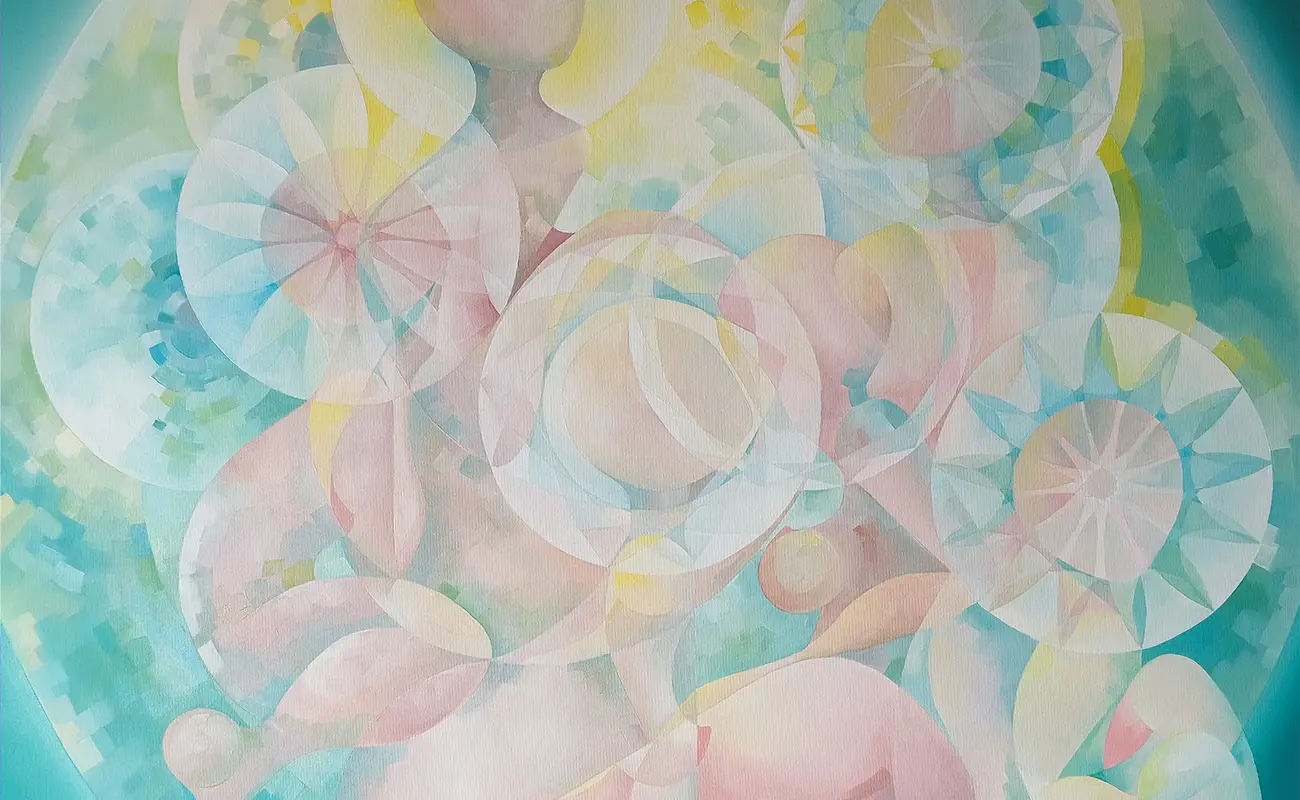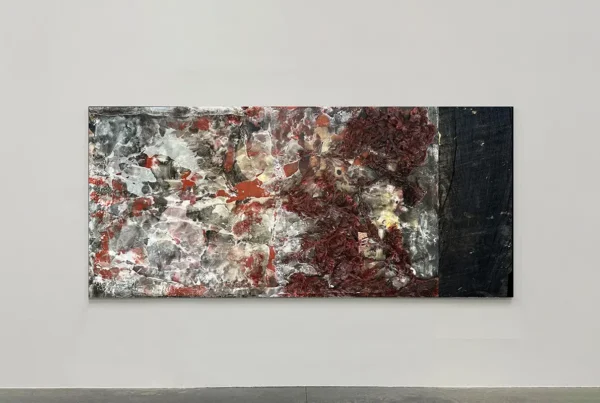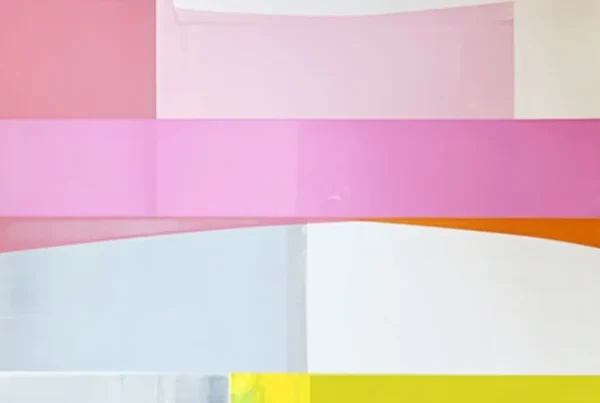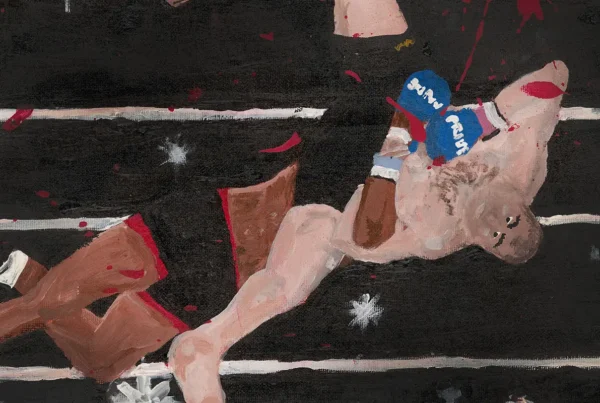“The process of self-discovery is incredibly captivating. It makes you believe that all the answers already lie within us.”
The Silent Precision of Form
There is an unmistakable clarity that emanates from Tetiana Gryshchenko’s work — a calm intensity shaped by her roots, her training, and an unwavering devotion to the structural truths of geometry. Born in the industrial port city of Mariupol and educated in Kharkiv, Ukraine, Gryshchenko has carried the weight of both place and transition into her creative journey. Now based in Croatia, she draws from a triad of cultural influences that shape not only her worldview but also her artistic voice. Her formal education in graphic design provided the analytical foundation for her current exploration of geometric abstraction, but it is her deep emotional engagement with the act of creation that defines the essence of her work. She speaks not just through color and composition, but through mathematical thought embedded within visual poetry.
At the center of Gryshchenko’s practice lies a dual force: an emotional urgency to materialize intangible ideas, and a contemplative devotion to geometry as a means of interpreting existence. Her canvases become meditative spaces where the emotional and the intellectual converse. This dialogue reflects a larger spiritual search for order, meaning, and continuity — a search grounded in ancient mathematical systems and the subtle beauty of recurring patterns in nature. Rather than merely aesthetic choices, the geometric structures she employs serve as frameworks through which she articulates deeper philosophical reflections. These frameworks do not impose limitations, but instead liberate form from chaos, allowing emotion to find clarity through symmetry and proportion.
It is not surprising, then, that Gryshchenko’s art emerges as both personal and universal. Her compositions offer viewers a gateway into visual experiences that resonate beyond cultural boundaries, inviting questions rather than imposing answers. There is a precision in her brushwork and structural layering that resists randomness, choosing instead to echo the subtle harmonies found in natural forms and cosmic order. This sense of deliberate construction is more than stylistic—it is a worldview, a way of making sense of the unknown. In her hands, geometry becomes more than mathematics; it becomes memory, intuition, and spiritual inquiry.

Tetiana Gryshchenko: Speaking in Symbols, Listening to Silence
The decision to leave a thriving career in design and devote herself entirely to painting was not one Gryshchenko took lightly. Her early inclination toward drawing, coupled with a deep inner conviction, led her to exchange the commercially driven world of design for the slower, introspective pace of fine art. This shift was not fueled by ambition, but by necessity — an internal need to commit fully to the creative process. In those formative years, her artistic direction was guided more by impulse than concept. Yet, even within these unplanned beginnings, an unmistakable structure began to emerge, revealing her intuitive alignment with order and symmetry. Her works gradually became spaces of inquiry, where visual language and symbolic depth started to align.
Over time, Gryshchenko’s practice evolved into a conscious synthesis of aesthetic, philosophical, and spiritual interests. She began embedding geometric sequences and symbolic forms beneath the surfaces of her works, often choosing systems like numerical progressions or harmonic ratios as compositional guides. These are not decorative elements, but conceptual tools — chosen to evoke universal truths and timeless questions. In her piece Graphics 24. Duality. Entities, she explores the tension between strength and fragility through a grid based on the progression of the number two. This deliberate use of structure subtly enhances the artwork’s theme of balance, revealing a sophisticated interplay between visible surface and hidden foundation. To Gryshchenko, such mathematical integrations are not didactic but devotional — they serve to honor the invisible forces that shape existence.
The themes in her work consistently orbit questions of being, unity, and transformation. While geometric symbols provide the vocabulary, the subject matter remains deeply human. She draws from ancient knowledge systems, reinterpreting them through a contemporary lens, thereby offering new modes of reflection for today’s viewer. The belief that understanding begins within and that art can awaken those dormant perceptions drives her to layer her pieces with more than just form. Each painting becomes an act of remembering — of recalling the symbolic structures once used to explain life, the cosmos, and the inner self. Gryshchenko does not just paint; she constructs portals between logic and emotion, the seen and the unseen.

Light Between Triangles
Among Gryshchenko’s body of work, Full Moon stands out not for its size or complexity, but for the intimacy of its creation and the layers of meaning it carries. Painted during a single evening under the glow of a full moon, the piece emerged in a moment of concentrated emotion. The brushstrokes, wide and flowing, reflect a spontaneous immediacy. Yet the painting’s simplicity belies its structural depth. Over time, it revealed itself differently under the soft light of a bedroom lamp, prompting the artist to revisit and alter it, not to correct a mistake but to express the essence of what she had truly seen each night. In this way, the work embodies both memory and transformation — a visual reworking of perception influenced by light, time, and contemplation.
At the painting’s conceptual heart lies the intersection of two triangles: one representing the static masculine, the other the dynamic feminine. Their union forms a symbol often identified as the Star of David, a motif rich with interpretations across cultures. Here, it serves as a meditation on duality and harmony — a quiet assertion that opposites can coexist not in conflict, but in resonance. The decision to call Full Moon a symbolic painting, rather than an ornament, signals its role as a vessel for layered meaning. It invites viewers to look beyond form into the interconnectedness of energies, elements, and identities. The painting functions not merely as a visual statement but as a reflection of inner alignment.
Another poignant work, The Vessel, continues this exploration of hidden systems and spiritual symbols. What first appears to be a static arrangement gradually unfolds into a dynamic meditation on life, birth, and the cyclical nature of existence. Drawing on the symbolic relationship between the human body and the pentacle, Gryshchenko incorporates the golden ratio and fractal geometry into the structure of the piece. By connecting mirrored Fibonacci spirals at their centers, she evokes the form of a heart — the “Fibonacci heart” — to symbolize love as the unifying principle of all creation. This work does not just describe a process of multiplication or growth; it visualizes it. The Vessel acts as both metaphor and mirror, prompting a reconsideration of where we begin and how we continue, infinitely nested within one another.
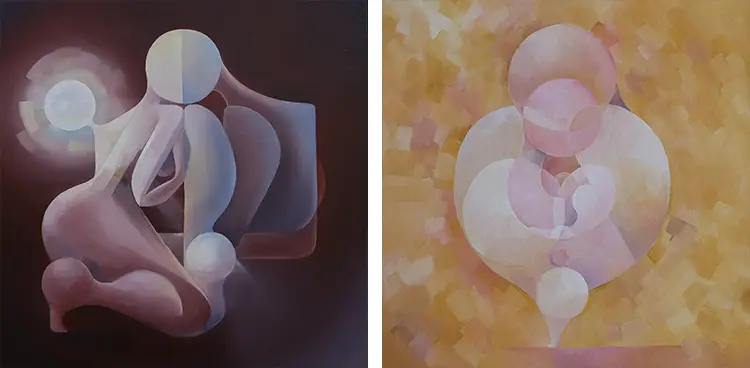
Tetiana Gryshchenko: A Language of Layers
Each day in Gryshchenko’s studio begins not with a blank canvas, but with a head full of ideas. Her artistic life is grounded in daily practice — painting, reading, and engaging with the philosophical and mathematical theories that fuel her conceptual framework. She considers herself at the beginning of a much larger journey, one in which artistic maturity is measured not by mastery alone, but by an expanding understanding of complexity. This openness to continual learning keeps her work in motion, driven by curiosity and sustained by discipline. Painting is not separate from study in her world; it is the natural extension of inquiry, a means of testing theories through material form.
Lately, Gryshchenko has been increasingly drawn to works that operate on multiple perceptual levels. She seeks to construct pieces that hold more than one interpretation, where surface aesthetics are underpinned by hidden structures and quiet narratives. This layered approach invites viewers to pause and return, allowing each encounter with the work to reveal something new. She describes this process as “playing” — not in a frivolous sense, but as an act of serious experimentation. Each painting becomes a puzzle, not just for the artist but for the audience as well, offering multiple entry points into the same idea. This complexity, she believes, reflects the way we perceive life itself: never in a single glance, but through accumulation and discovery.
The future of her practice lies in deepening this visual language. Gryshchenko aims to integrate increasingly intricate systems of symbolism and structure into her art, crafting experiences that are both visually compelling and intellectually expansive. Her mission is not to explain, but to suggest — to awaken a sense of recognition in the viewer, an intuitive grasp of something ancient yet familiar. In doing so, she bridges the gaps between art and science, emotion and form, the personal and the universal. Through the silent eloquence of geometry, she continues to build a body of work that speaks in patterns, resonates in symbols, and lingers in the space between what is seen and what is understood.
